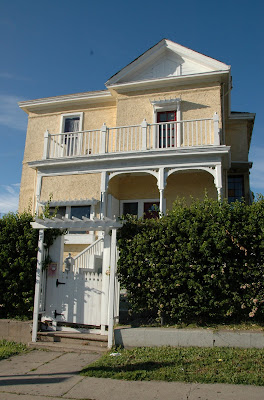We headed up to the Meditation Gardens in the Self-Realization Fellowship Retreat and Hermitage in Encinitas at the advice of Charles Boyd, a Charlestonian temporarily displaced in San Diego and now back in Charleston.
"It's not really sightseeing because it's in San Diego", Jennifer rationalized on the drive up. "I don't like sightseeing, Mommy always wants to do that when we go on vacation".

A Golden Lotus tower meets every traveler arriving into town from the south on historic Highway 101. Behind the tower lies the seventeen acre Self-Realization Fellowship (SRF) for prayer and meditation. Most of the grounds are taken up by the Hermitage and Retreat. A few bluffside acres, perhaps two, of unbelievable beauty and serenity are dedicated to a Meditation Garden.
Before we got to the gardens, I took the opportunity to slip some history of Encinitas into the conversation. We drove past the Darby House and talked about the railroad beginnings of Encinitas, then past the Boat Houses and talked about how building the dams at Lake Hodges and San Dieguito in 1918 influenced the growth of the little town.
A mining engineer, James Noonan, bought the SRF property in 1887, built a house and moved his family here from Colorado. The house burnt to the ground six years later and the family moved away. Certainly there would have been no water to fight a fire at that time.
In 1936, James Lynn, a follower of Paramahansa Yogananda, bought the property and built the Hermitage on the bluffs, presenting it to him as a gift when he returned from a tour in Europe and India. Paramanhansa Yogananda lived and taught here in the Hermitage for the next twenty five years until his death in 1952.
Every inch of the gardens is beauty, bringing the beholder to a slow pace to absorb it all.

Gnarled trees give a feeling this place has been here forever. I missed the Ming Tree planted by the Yogi. That will have to be another trip.

Koi ponds...

Giant golden fish...

Beautiful blooming seaside succulents...

Weird little guys growing on rocks.

A Golden Lotus temple designed by Parmahansa Yogananda was built on the edge of the cliff in 1938 with a large pond to the side that mirrored the temple.

Unfortunately, the Temple slid down the cliffs in 1943, leaving only these steps.

Benches are placed everywhere in the gardens. These two couples sat unmoving for a long time. Thinking, praying, meditating?

Jennifer, a future film director, was completely absorbed photographing the gardens.

Her photos were a creative take on the environment.
 Photo by Jennifer
Photo by Jennifer Photo by Jennifer
Photo by JenniferShe waited what seemed like hours for this dove to pop his head from behind the branch.
 Photo by Jennifer
Photo by JenniferShe caught the entanglement of a pine tree by nearby palm roots.
 Photo by Jennifer
Photo by JenniferWe topped off the day with cheeseburger, fries, and a milkshake at the Highway 101 Diner -- ugh! I didn't want to think about the fat grams! -- took a look at the 1883 school house, located the 1926 sidewalk concrete stamp, and went to that funky outdoor market where she bought three cool shirts. I think I'll be having a buddy on future walkabouts.
"Let us pray in our hearts for a League of Souls and a United World. Though we may seem divided by race, creed, color, class, and political prejudices, still, as children of the one God we are able in our souls to feel brotherhood and world unity. May we work for the creation of a United World in which every nation will be a useful part, guided by God through man's enlightened conscience.- Paramanhansa Yogananda -
In our hearts we can all learn to be free from hate and selfishness. Let us pray for harmony among the nations, that they march hand in hand through the gate of a fair new civilization."




















